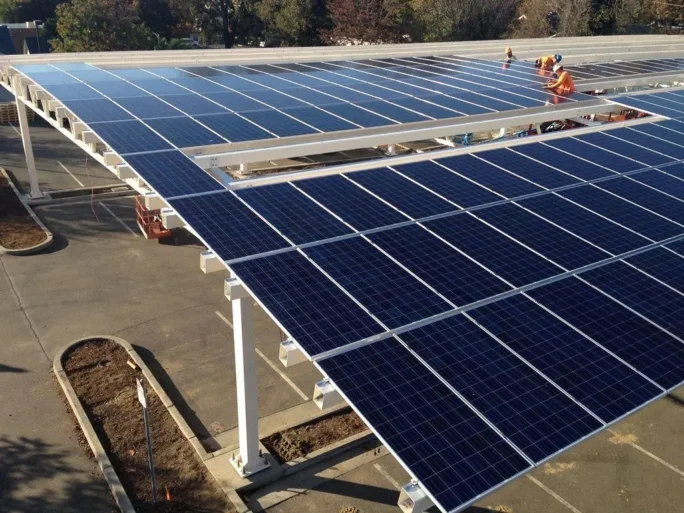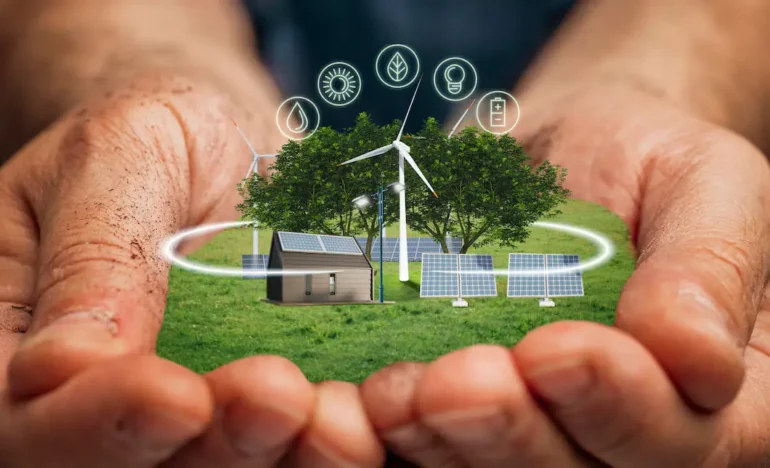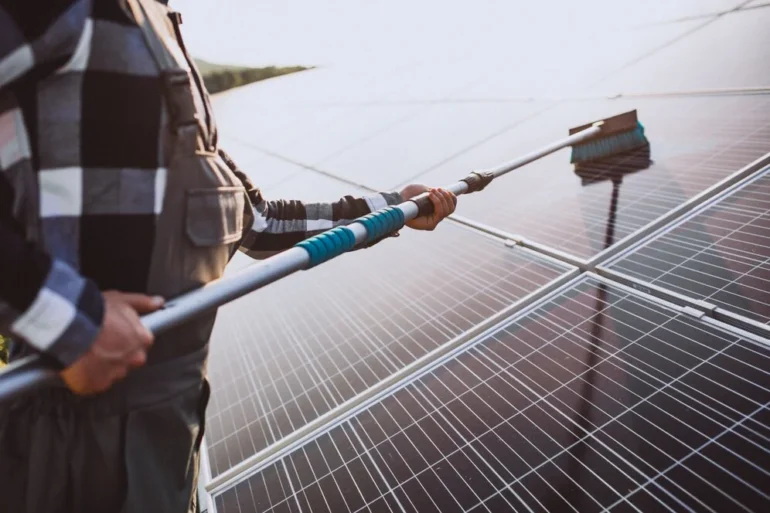Unlocking the potential of solar energy offers a pathway to a cleaner, more sustainable future. In this comprehensive guide, we delve into how solar energy works, from its fundamental definition to its crucial role in renewable energy sources. Exploring the essence of solar radiation and photovoltaics, we unravel the mechanisms behind harnessing sunlight and converting it into usable electricity. From residential rooftops to vast solar farms, solar energy applications and technologies are transforming the way we power our homes, businesses, and communities. Join us on a journey to discover the boundless possibilities of solar energy and its profound impact on shaping a greener tomorrow.
Definition of Solar Energy
Solar energy, often hailed as a sustainable and renewable source of power, encompasses the radiant energy emitted by the sun. This energy, in the form of electromagnetic radiation, is harnessed through various technologies to generate electricity, heat, and light. At its core, solar energy is the driving force behind many natural processes on Earth, including photosynthesis, weather patterns, and the water cycle.
Solar energy is primarily captured through photovoltaic technology, where solar panels or modules containing photovoltaic cells absorb sunlight and convert it into electricity. These cells are typically made of semiconductor materials such as silicon, which generate an electric current when exposed to sunlight. This phenomenon, known as the photovoltaic effect, forms the basis of solar power generation.
Understanding Solar Radiation and Photovoltaics
Solar radiation, also known as solar insolation, refers to the electromagnetic radiation emitted by the Sun, including visible light, infrared radiation, and ultraviolet light. This radiation reaches the Earth’s surface and provides the energy necessary for various natural processes, including photosynthesis and climate dynamics. Photovoltaics is the technology used to convert solar radiation into electricity, primarily through the use of solar panels composed of photovoltaic cells.
How Solar Energy Works
Solar panels operate on the principle of the photovoltaic effect, where sunlight is converted directly into electricity.
Explanation of the Photovoltaic Effect
The photovoltaic effect is the process by which solar cells convert sunlight into electricity. When photons from sunlight strike the surface of a solar cell, they excite electrons within the semiconductor material, causing them to break free from their atoms. This generates an electric current, which is captured by metal contacts within the cell. The flow of electrons through these contacts creates a direct current (DC) of electricity.
How Solar Panels Work to Convert Sunlight into Electricity
Solar panels consist of numerous solar cells connected in series and parallel. These cells are typically made of silicon, a semiconductor material. When sunlight hits the solar panels, photons knock electrons loose from the atoms in the silicon cells. The loose electrons then flow through the material, creating an electric current. This current is captured by metal contacts on the solar cells, generating DC electricity. An inverter then converts this DC electricity into alternating current (AC) suitable for use in homes and businesses.
 Materials and Technology Used in Solar Panels
Materials and Technology Used in Solar Panels
Solar panels primarily use crystalline silicon-based solar cells, which come in two main types: monocrystalline and polycrystalline. Monocrystalline cells are made from a single crystal structure, offering higher efficiency and longevity but at a higher cost. Polycrystalline cells are made from multiple silicon fragments, providing slightly lower efficiency but at a more affordable price. Thin-film solar cells, made from materials like cadmium telluride or amorphous silicon, offer flexibility and potential cost savings in specific applications. These materials and technologies continue to evolve, leading to improvements in solar panel efficiency, durability, and affordability.
Capturing Solar Energy: Photovoltaic Effect
The photovoltaic effect is the fundamental principle behind solar energy generation, where sunlight is directly converted into electricity.
Explanation of the Photovoltaic Effect
The photovoltaic effect occurs within solar cells, which are made of semiconductor materials such as silicon. When sunlight, comprised of photons, strikes the surface of a solar cell, it excites electrons within the semiconductor material. These excited electrons break free from their atoms and create a flow of electric charge. This flow of electrons constitutes an electric current, which can be captured and utilized as electricity.
Role of Semiconductor Materials
Semiconductor materials play a crucial role in the photovoltaic effect. Silicon is the most commonly used semiconductor material in solar cells due to its abundance and desirable electrical properties. Silicon atoms are arranged in a crystalline structure within the solar cell, creating a lattice that allows for the movement of electrons. When sunlight hits the silicon lattice, it provides the energy necessary to dislodge electrons from their atoms, initiating the flow of electric charge.
Converting Solar Energy into Electrical Energy
The process of converting solar energy into electrical energy begins with the absorption of sunlight by solar panels composed of interconnected solar cells. As sunlight strikes the solar panel, it excites electrons in the silicon semiconductor material, generating an electric current. This direct current (DC) is then fed into an inverter, which converts it into alternating current (AC) suitable for use in homes and businesses.
AC electricity can power various electrical appliances, lighting, and other devices, thereby harnessing the energy of the sun to meet our daily energy needs. Through the photovoltaic effect, solar panels enable the efficient and sustainable conversion of solar energy into usable electrical energy, contributing to the transition towards renewable energy sources.
Conversion of Solar Energy into Electricity
Solar energy, harnessed through photovoltaic systems, undergoes a complex process to transform sunlight into usable electricity.
Inverters and Their Function in Converting DC to AC
Inverters are critical components of solar power systems, responsible for converting the direct current (DC) generated by solar panels into alternating current (AC) usable by electrical appliances. The DC electricity produced by solar panels is inherently different from the AC electricity used in homes and businesses. Inverters perform the essential task of changing the electrical characteristics of the current to match the requirements of the electrical grid and household devices.
This conversion process involves several stages, including rectification, inversion, and voltage regulation. Inverters ensure that the electricity generated by solar panels is synchronized with the grid’s frequency and voltage, allowing for seamless integration with existing electrical systems.
Electrical Systems in Solar Power Generation
Solar power generation encompasses various electrical systems that work together to harness, convert, and distribute solar energy. At the heart of these systems are solar panels, composed of photovoltaic cells that directly convert sunlight into electricity through the photovoltaic effect. Once electricity is generated, it flows into an inverter, where it undergoes conversion from DC to AC. From the inverter, the AC electricity is directed to the main electrical panel of the building, where it can be used to power appliances and devices.
Electrical systems in solar power generation often include components such as charge controllers, battery storage systems, and monitoring equipment to optimize energy production and usage.
Distribution of Electricity Generated by Solar Panels
Once electricity is converted into AC by the inverter, it is distributed throughout the building’s electrical system via the main electrical panel. The distribution process involves routing the electricity to different circuits and outlets within the building, allowing occupants to access solar-generated power for their energy needs. Excess electricity generated by solar panels that is not immediately consumed can be fed back into the grid through a process known as net metering.
This allows solar system owners to receive credits or compensation for the surplus energy they contribute to the grid, further incentivizing the adoption of solar energy. Overall, the distribution of electricity generated by solar panels enables buildings to become more self-sufficient and environmentally friendly while reducing reliance on traditional fossil fuel-based electricity sources.
Components of a Solar Power System
A solar power system consists of several key components that work together to harness solar energy and convert it into usable electricity.
Solar Panels and Their Composition
Solar panels, also known as photovoltaic (PV) modules, are the primary components of a solar power system responsible for capturing sunlight and converting it into electricity through the photovoltaic effect. These panels are composed of multiple solar cells made from semiconductor materials, typically silicon. When sunlight strikes the solar cells, it excites electrons, creating an electric current. The solar cells are encased in a protective layer of glass and encapsulant to withstand environmental factors and ensure durability.
Types of Racking and Mounting Systems
Racking and mounting systems are crucial components of solar power systems that support and secure solar panels in place. These systems come in various designs and configurations to accommodate different installation requirements and environments. Common types of racking systems include roof mounts, ground mounts, and tracking mounts. Roof mounts are installed directly onto the roof structure, while ground mounts are placed on the ground or a supporting structure.
Tracking mounts, such as single-axis and dual-axis trackers, allow solar panels to follow the sun’s path throughout the day, maximizing energy production. Racking systems are typically made from durable materials like aluminum or steel and are designed to withstand wind, snow, and other environmental loads.
 Other Components
Other Components
In addition to solar panels and racking systems, solar power systems include various other components essential for their operation and performance. These components may include inverters, which convert the DC electricity generated by solar panels into AC electricity compatible with the electrical grid or household appliances. Charge controllers regulate the flow of electricity between solar panels and battery storage systems, preventing overcharging or discharging.
Battery storage systems store excess solar energy for use during periods of low sunlight or high energy demand. Monitoring systems track the performance and output of the solar power system, providing valuable data for optimization and maintenance. Overall, these components work in concert to maximize the efficiency, reliability, and longevity of solar power systems for both residential and commercial applications.
Grid-Tied vs. Off-Grid Solar Systems
When considering solar energy solutions, it’s essential to understand the differences between grid-tied and off-grid systems, as each offers unique benefits and considerations.
Grid-Tied Systems and Their Connection to the Utility Grid
Grid-tied solar systems are connected to the local utility grid, allowing homeowners and businesses to supplement their electricity needs with solar power while remaining connected to the grid. These systems utilize solar panels to generate electricity during the day, which is then used to power the property’s electrical loads. Any excess electricity produced by the solar panels can be exported back to the grid, often earning credits or compensation through net metering programs. Grid-tied systems do not require battery storage, as the grid serves as a backup source of power during periods of low sunlight or high energy demand.
Off-Grid Systems and Their Self-Sufficiency
In contrast, off-grid solar systems operate independently of the utility grid and rely on battery storage to store excess solar energy for use when sunlight is unavailable. Off-grid systems are commonly used in remote or rural areas where grid connection is impractical or cost-prohibitive. These systems typically include solar panels, a charge controller, battery storage, and an inverter to convert DC electricity from the solar panels into AC electricity for household use. Off-grid systems require careful sizing and design to ensure they can meet the property’s energy demands throughout the year, especially during periods of low sunlight or inclement weather.
Applications and Advantages of Each System Type
Grid-tied systems are ideal for homeowners and businesses looking to reduce their electricity bills and minimize their carbon footprint while maintaining the convenience of grid connection. These systems are well-suited for urban and suburban areas where grid reliability is high and net metering incentives are available. On the other hand, off-grid systems offer energy independence and resilience against grid outages, making them suitable for remote cabins, RVs, boats, and other off-grid applications.
While off-grid systems require more upfront investment in battery storage, they provide autonomy and peace of mind for users seeking self-sufficiency. Understanding the differences between grid-tied and off-grid solar systems enables consumers to choose the solution that best fits their energy needs, lifestyle, and location.
Environmental Benefits of Solar Energy
Solar energy offers a multitude of environmental advantages, making it a sustainable alternative to traditional fossil fuels and a crucial component of mitigating climate change.
Reduction of Carbon Emissions and Greenhouse Gases
One of the most significant environmental benefits of solar energy is its ability to reduce carbon emissions and other harmful pollutants. Unlike fossil fuels such as coal, oil, and natural gas, solar power generation produces no greenhouse gases or air pollutants during operation. By harnessing energy from the sun, solar panels generate electricity without emitting carbon dioxide (CO2), sulfur dioxide (SO2), nitrogen oxides (NOx), or other harmful pollutants that contribute to air pollution and climate change.
The widespread adoption of solar energy helps to decrease reliance on fossil fuels, thereby reducing overall carbon emissions and improving air quality in communities around the world.
Preservation of Natural Resources and Ecosystems
Solar energy also plays a crucial role in preserving natural resources and ecosystems by reducing the demand for finite resources such as coal, oil, and natural gas. Unlike fossil fuel extraction and combustion, which require significant land disturbance, water consumption, and habitat destruction, solar power generation has minimal environmental impact.
Solar panels can be installed on rooftops, parking lots, and other underutilized spaces without disrupting natural habitats or landscapes. Solar energy reduces the need for environmentally damaging practices such as mountaintop removal mining, fracking, and offshore drilling, which can have detrimental effects on biodiversity, water quality, and land degradation.
 Contribution to Combating Climate Change and Global Warming
Contribution to Combating Climate Change and Global Warming
Solar energy is a key contributor to combating climate change and global warming by providing a clean, renewable alternative to fossil fuels. The combustion of fossil fuels releases vast amounts of CO2 and other greenhouse gases into the atmosphere, leading to the enhanced greenhouse effect and resulting in rising global temperatures. By transitioning to solar energy and other renewable sources, society can significantly reduce greenhouse gas emissions and mitigate the impacts of climate change.
Solar power generation helps to stabilize the Earth’s climate by providing a sustainable energy solution that does not contribute to the accumulation of greenhouse gases in the atmosphere. This transition to clean energy is essential for safeguarding the planet’s ecosystems, biodiversity, and the well-being of present and future generations.
Economic Considerations and Incentives
When considering the adoption of solar energy, various economic factors and incentives come into play, influencing the decision-making process and overall feasibility of solar installations.
Cost Savings
One of the primary economic considerations of solar energy is its potential for long-term cost savings. While the initial investment in solar panel installation and equipment may seem significant, the savings generated over the system’s lifespan can offset these costs significantly. Solar panels have a relatively low operational and maintenance cost compared to traditional fossil fuel-based energy sources.
Once installed, solar panels harness free and abundant sunlight to generate electricity, reducing or even eliminating monthly electricity bills. Homeowners, businesses, and organizations can enjoy substantial savings on their energy expenses over time, making solar energy an attractive investment in the long run.
Tax Credits, Rebates, and Incentives
Governments at the federal, state, and local levels offer various tax credits, rebates, and incentives to encourage the adoption of solar energy systems. These financial incentives help offset the upfront costs of solar panel installation and make renewable energy more accessible and affordable for homeowners and businesses. The federal Investment Tax Credit (ITC) allows eligible homeowners and businesses to claim a percentage of their solar installation costs as a tax credit, effectively reducing their tax liability.
Many states and local utilities offer rebates and incentives for solar installations, further lowering the initial investment and improving the financial return on investment for solar energy systems.
Financing Options
In addition to tax credits and incentives, there are various financing options available to help individuals and businesses finance their solar energy projects. Solar financing options include solar loans, solar leases, power purchase agreements (PPAs), and property-assessed clean energy (PACE) financing. Solar loans allow homeowners and businesses to finance their solar installations through loans offered by banks, credit unions, or solar financing companies. Solar leases and PPAs enable customers to lease or purchase solar panels from third-party providers and pay for the electricity generated by the system at a predetermined rate.
PACE financing allows property owners to finance their solar installations through their property tax assessments, with repayment spread out over time. These financing options make solar energy more accessible and affordable for a broader range of customers, driving further adoption and deployment of solar energy systems across the country.
Conclusion
Solar energy represents a promising and sustainable solution to our growing energy needs while mitigating environmental impact. Through harnessing the power of sunlight, solar panels generate clean electricity without emitting harmful greenhouse gases or depleting finite natural resources. The technology behind solar energy continues to advance, making it more efficient, affordable, and accessible than ever before. As we strive to transition towards a more sustainable energy future, solar power stands out as a key player in reducing carbon emissions, combating climate change, and promoting energy independence. By understanding the environmental, economic, and social benefits of solar energy, individuals, businesses, and governments can make informed decisions to embrace this renewable energy source and contribute to a cleaner and brighter future for generations to come.
FAQs
How long do solar panels last?
Solar panels typically have a lifespan of 25 to 30 years, with most manufacturers offering warranties for this duration.
Can solar panels work during cloudy days or at night?
While solar panels are most effective in direct sunlight, they can still generate electricity on cloudy days. However, their efficiency may be reduced. Solar panels do not generate electricity at night, but excess energy can be stored in batteries for use when sunlight is not available.
Are there any maintenance requirements for solar panels?
Solar panels require minimal maintenance, usually limited to occasional cleaning to remove dirt and debris that may accumulate on the surface. Additionally, it’s recommended to have a professional inspection every few years to ensure optimal performance and longevity.







